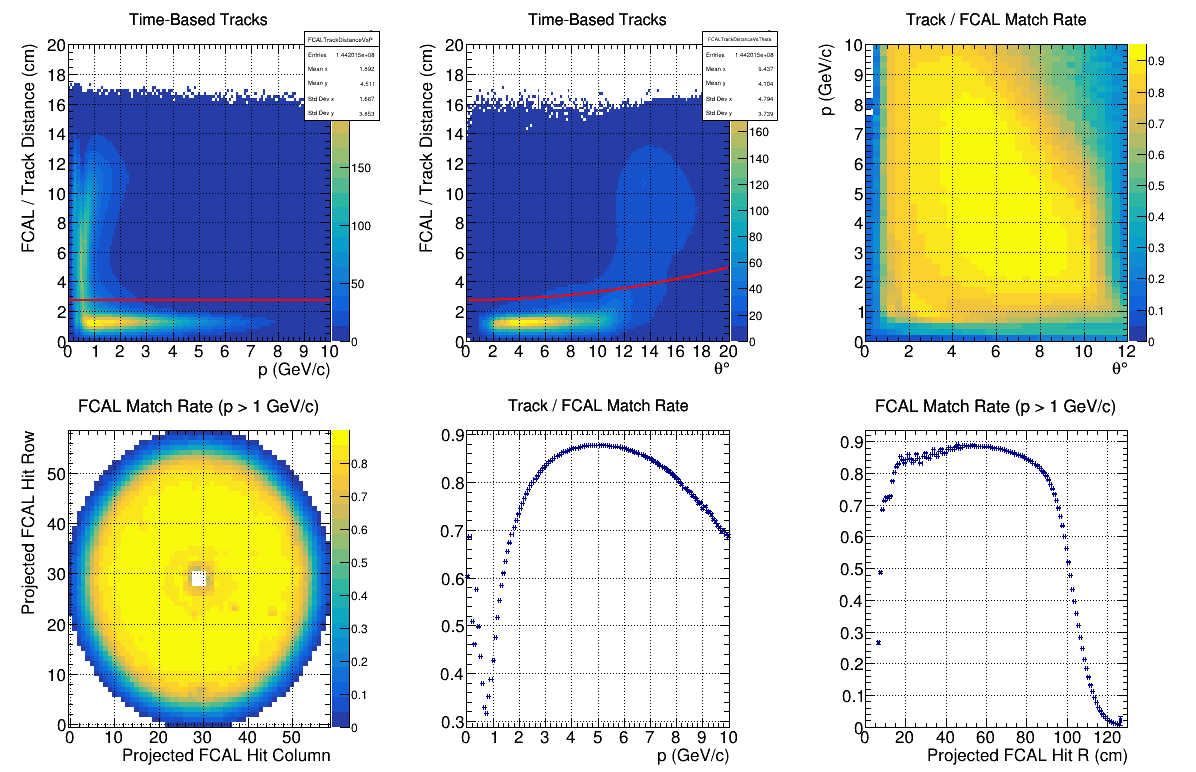Alex,
I think you are correct in looking at the FCAL component of the trigger for the source of these excess low-momentum tracks. Can you see if the excess small-angle tracks below the beam hole come in the same events with the ones in the first quadrant? I am suspecting e+e- pairs, where both local peaks are brought in by a trigger acceptance in one of the two regions. A test of this would be to look for a correlation between tracks matching in the first quadrant where the trigger selects them (not there in MC sample or in the random events) and tracks that match to the accumulation below the beam hole.
-Richard J.
On Tue, Sep 14, 2021 at 11:31 AM Alex Austregesilo @.***> wrote:
Comparing the monitoring plots for a recent bggen sample with the real data reconstruction, I noticed a striking difference in the track matching rate for small radii around the beam hole.
For real data (e.g. 2017), we see an accumulation of tracks matched to showers for R<20cm (bottom row, right plot). The extra showers are mostly located in the 1st quadrant, which corresponds to the region where some of the inner FCal blocks were not masked in the trigger (bottom row, left plot), but there is a second cluster below the hole. [image: recon_ver03] https://camo.githubusercontent.com/a32573981c6460e69f6b5c6da1212dd9f5896b6d26f655aa0c86e9fae6455d38/68747470733a2f2f68616c6c647765622e6a6c61622e6f72672f776f726b2f68616c6c64322f646174615f6d6f6e69746f72696e672f52756e506572696f642d323031372d30312f7265636f6e5f76657230332f52756e3033303733302f486973744d6163726f5f4d61746368696e675f4643414c2e706e67
In the MC sample, this is effect is not simulated. Could there be a background component that is beam-correlated, which is not taken into account properly by the random trigger background?
— You are receiving this because you are subscribed to this thread. Reply to this email directly, view it on GitHub https://github.com/JeffersonLab/HDGeant4/issues/196, or unsubscribe https://github.com/notifications/unsubscribe-auth/AB3YKWC2VITTA5EJ27PCOYTUB5TGVANCNFSM5EANZA7A . Triage notifications on the go with GitHub Mobile for iOS https://apps.apple.com/app/apple-store/id1477376905?ct=notification-email&mt=8&pt=524675 or Android https://play.google.com/store/apps/details?id=com.github.android&referrer=utm_campaign%3Dnotification-email%26utm_medium%3Demail%26utm_source%3Dgithub.
 I assume there is just no EM background to trigger any events. I will try the BeamPhotons background or directly some BH signal.
I assume there is just no EM background to trigger any events. I will try the BeamPhotons background or directly some BH signal. 









Comparing the monitoring plots for a recent bggen sample with the real data reconstruction, I noticed a striking difference in the track matching rate for small radii around the beam hole.
For real data (e.g. 2017), we see an accumulation of tracks matched to showers for R<20cm (bottom row, right plot). The extra showers are mostly located in the 1st quadrant, which corresponds to the region where some of the inner FCal blocks were not masked in the trigger (bottom row, left plot), but there is a second cluster below the hole.
In the MC sample, this is effect is not simulated. Could there be a background component that is beam-correlated, which is not taken into account properly by the random trigger background?